
Astronomy is the oldest of the natural sciences, dating back to antiquity, with its origins in the religious, mythological, cosmological, calendrical, and astrological beliefs and practices of prehistory: vestiges of these are still found in astrology, a discipline long interwoven with public and governmental astronomy. It was not completely separated in Europe during the Copernican Revolution starting in 1543. In some cultures, astronomical data was used for astrological prognostication.

Johannes Kepler was a German astronomer, mathematician, astrologer, natural philosopher and writer on music. He is a key figure in the 17th-century Scientific Revolution, best known for his laws of planetary motion, and his books Astronomia nova, Harmonice Mundi, and Epitome Astronomiae Copernicanae, influencing among others Isaac Newton, providing one of the foundations for his theory of universal gravitation. The variety and impact of his work made Kepler one of the founders and fathers of modern astronomy, the scientific method, natural and modern science.

Prague is the capital and largest city of the Czech Republic and the historical capital of Bohemia. On the Vltava river, Prague is home to about 1.3 million people. The city has a temperate oceanic climate, with relatively warm summers and chilly winters.
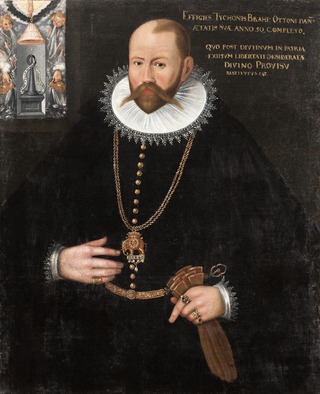
Tycho Brahe, generally called Tycho for short, was a Danish astronomer of the Renaissance, known for his comprehensive and unprecedentedly accurate astronomical observations. He was known during his lifetime as an astronomer, astrologer, and alchemist. He was the last major astronomer before the invention of the telescope.
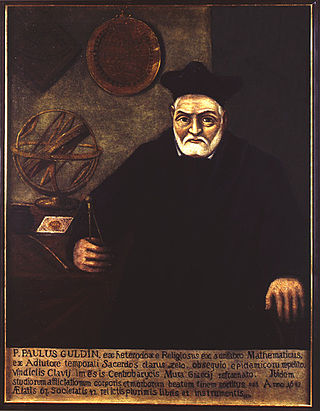
Paul Guldin was a Swiss Jesuit mathematician and astronomer. He discovered the Guldinus theorem to determine the surface and the volume of a solid of revolution. Guldin was noted for his association with the German mathematician and astronomer Johannes Kepler. Guldin composed a critique of Cavalieri's method of Indivisibles.

The Prague astronomical clock or Prague Orloj is a medieval astronomical clock attached to the Old Town Hall in Prague, the capital of the Czech Republic.
Owen Jay Gingerich was an American astronomer who had been professor emeritus of astronomy and of the history of science at Harvard University and a senior astronomer emeritus at the Smithsonian Astrophysical Observatory. In addition to his research and teaching, he had written many books on the history of astronomy.

Jost Bürgi, active primarily at the courts in Kassel and Prague, was a Swiss clockmaker, a maker of astronomical instruments and a mathematician.

Michael Maestlin was a German astronomer and mathematician, known for being the mentor of Johannes Kepler. He was a student of Philipp Apian and was known as the teacher who most influenced Kepler. Maestlin was considered to be one of the most significant astronomers between the time of Copernicus and Kepler.
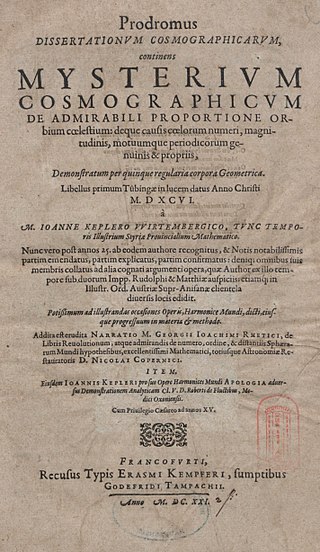
Mysterium Cosmographicum is an astronomy book by the German astronomer Johannes Kepler, published at Tübingen in late 1596 and in a second edition in 1621. Kepler proposed that the distance relationships between the six planets known at that time could be understood in terms of the five Platonic solids, enclosed within a sphere that represented the orbit of Saturn.
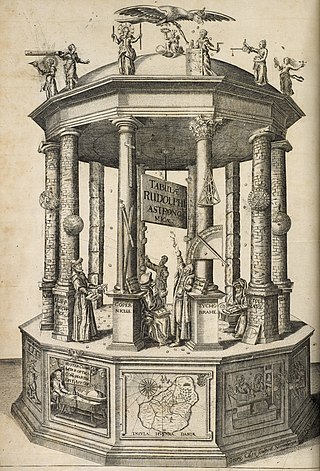
The Rudolphine Tables consist of a star catalogue and planetary tables published by Johannes Kepler in 1627, using observational data collected by Tycho Brahe (1546–1601). The tables are named in memory of Rudolf II, Holy Roman Emperor, in whose employ Brahe and Kepler had begun work on the tables. The main purpose of the Rudolphine tables was to allow the computation of the positions of the then known planets of the Solar System, and they were considerably more precise than earlier such tables.

The International Year of Astronomy (IYA2009) was a year-long celebration of astronomy that took place in 2009 to coincide with the 400th anniversary of the first recorded astronomical observations with a telescope by Galileo Galilei and the publication of Johannes Kepler's Astronomia nova in the 17th century. The Year was declared by the 62nd General Assembly of the United Nations. A global scheme, laid out by the International Astronomical Union (IAU), was also endorsed by UNESCO, the UN body responsible for educational, scientific, and cultural matters.

The Great Comet of 1577 is a non-periodic comet that passed close to Earth during the year 1577 AD. Being classed as non-periodic, indicated by its official designation beginning with "C", means that it is not expected to return. In 1577, the comet was visible to all of Europe, and was recorded by many contemporaries of the time, including the famous Danish astronomer Tycho Brahe and Turkish astronomer Taqi ad-Din. From his observations of the comet, Brahe was able to discover that comets and similar objects travel above the Earth's atmosphere. The best fit using JPL Horizons suggests that the comet is currently about 324 AU (48.5 billion km) from the Sun.

The Prutenic Tables, were an ephemeris by the astronomer Erasmus Reinhold published in 1551. They are sometimes called the Prussian Tables after Albert I, Duke of Prussia, who supported Reinhold and financed the printing. Reinhold calculated this new set of astronomical tables based on Nicolaus Copernicus' De revolutionibus orbium coelestium, the epochal exposition of Copernican heliocentrism published in 1543. Throughout his explanatory canons, Reinhold used as his paradigm the position of Saturn at the birth of the Duke, on 17 May 1490. With these tables, Reinhold intended to replace the Alfonsine Tables; he added redundant tables to his new tables so that compilers of almanacs familiar with the older Alfonsine Tables could perform all the steps in an analogous manner.
Giovanni de Galliano Pieroni (1586–1654) was a military engineer specialized in erecting fortifications, architect, mathematician and astronomer who gained particular fame in his day as also as author of horoscopes. Early in his life, he became friendly with the astronomer, mathematician and physicist Galileo Galilei (1564-1642) – like Pieroni, Galileo also wrote on constructing fortifications, and the two shared interest in mathematics and astronomy. He was also a contemporary and friend of Johannes Kepler (1571-1630) while both spent time in Prague.

Vojtěch Sedláček is a Czech entrepreneur, who established Obsluzna spol. (1995) and Agentura ProVas (1996). Both companies have a mission of creating employment and business opportunities for people with disabilities. In 1973 Vojtech Sedlacek married with Jaroslava Vagnerova, they raised four daughters and one son.

Miloš Slovák was a Czechoslovak painter and commercial artist.
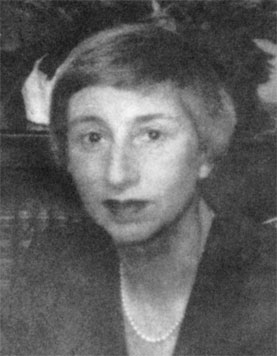
Clarisse Doris Hellman Pepper was an American historian of science, "one of the first professional historians of science in the United States". She specialized in 16th- and 17th-century astronomy, wrote a book on the Great Comet of 1577, and was the translator of another book, a biography of Johannes Kepler. She became a professor at the Pratt Institute and later at the Queens College, City University of New York, and was recognized by membership in several selective academic societies.
Alena Šolcová is a Czech mathematician and science historian. She is the founder of the Kepler Museum, an astronomy museum in Prague.
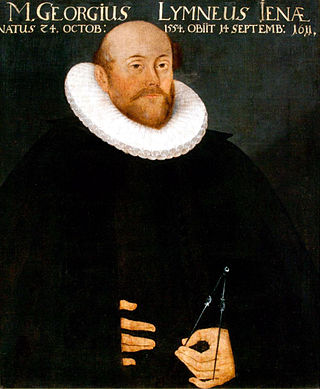
Georg Limnaeus was a German mathematician, astronomer and librarian, who provided noteworthy encouragement to Johannes Kepler shortly after his first heliocentric astronomical work was published.



















